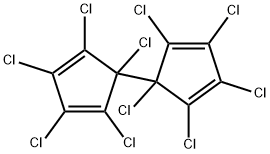| Company Name: |
BEST-REAGENT
|
| Tel: |
400-1166-196 18981987031 |
| Email: |
cdhxsj@163.com |
| Products Intro: |
Product Name:DIENOCHLOR
CAS:2227-17-0
Purity:99% HPLC Package:10g;50g;100g;500g;1kg;5kg;25kg
|
| Company Name: |
Shanghai JONLN Reagent Co., Ltd.
|
| Tel: |
400-0066400 13621662912 |
| Email: |
422131432@qq.com |
| Products Intro: |
Product Name:Dienochlor 0.2
CAS:2227-17-0
Package:773RMB/ 250mg
|
| Company Name: |
Alta Scientific Co., Ltd.
|
| Tel: |
022-6537-8550 15522853686 |
| Email: |
sales@altasci.com.cn |
| Products Intro: |
Product Name:Dienochlor
CAS:2227-17-0
Purity:99% Package:10mg,100mg
|
|
| | DIENOCHLOR Basic information |
| Product Name: | DIENOCHLOR | | Synonyms: | 1,1',2,2',3,3',4,4',5,5'-DECACHLOROBI-2,4-CYCLOPENTADIEN-1-YL;1,1’,2,2’,3,3’,4,4’,5,5’-decachlorobi-2,4-cyclopentadien-1-yl;1,1’,2,2’,3,3’,4,4’,5,5’-decachloro-bi-4-cyclopentadien-1-yl;1,1’2,2’,3,3’4,4’,5,5’-Decachlorodi-2,4-cy-clo-pentadien-1-yl;PENTAC;PENTAC (TM);DECACHLOROBIS(2,4-CYCLOPENTADIENE-1-YL);DIENOCHLOR | | CAS: | 2227-17-0 | | MF: | C10Cl10 | | MW: | 474.64 | | EINECS: | 218-763-5 | | Product Categories: | AcaricidesPesticides&Metabolites;Alpha sort;D;DAlphabetic;DID - DIN;Pesticides;Pesticides&Metabolites | | Mol File: | 2227-17-0.mol |  |
| | DIENOCHLOR Chemical Properties |
| Melting point | 122-123℃ | | Boiling point | 547.24°C (rough estimate) | | density | 1.8769 (rough estimate) | | vapor pressure | 2.9 x 10-4 Pa (25 °C) | | refractive index | 1.6000 (estimate) | | Water Solubility | 0.025 mg l-1 | | Merck | 13,3131 | | BRN | 2064747 | | EPA Substance Registry System | Dienochlor (2227-17-0) |
| Hazard Codes | Xn | | Risk Statements | 22 | | Safety Statements | 22-24 | | RIDADR | 2761 | | WGK Germany | 3 | | RTECS | DT8225000 | | HazardClass | 6.1(a) | | PackingGroup | I | | Hazardous Substances Data | 2227-17-0(Hazardous Substances Data) | | Toxicity | Acute oral LD50 for male albino rats >3.16 g/kg, bobwhite quail 705 mg/kg (Worthing and Hance, 1991). |
| | DIENOCHLOR Usage And Synthesis |
| Uses | Acaricide used for control of mites on ornamentals. | | Uses | Dienochlor is used for the control of mites (Tetrunychus spp.,
Panonychus ulmi and Polyphagotarsonemus latus) on roses, Chrysanthemums
and other ornamentals. | | Uses | Miticide. | | Definition | ChEBI: Dienochlor is an organochlorine compound. | | Environmental Fate | Plant. On plants, dienochlor was converted by sunlight to form perchloro ketones (Quistad and Mulholland, 1983).
Chemical/Physical. Dienochlor is unstable when exposed to sunlight. When dienochlor applied as a thin ?lm on glass plates was exposed to sunlight, nonpolar products, a tricyclic chlorocarbon and 3 isomeric perchloro ketones were formed at yields
Dienochlor begins to decompose at 130°C (Worthing and Hance, 1991). | | Metabolic pathway | Dienochlor is readily degraded in sunlight to many products, only a few
of which have been identified. It is also metabolised in animals but to
unknown products. In vitro studies have shown that it interacts with thiols
(glutathione, cysteine, efc.) and proteins. | | Metabolism | Dienochlor decomposes in simulated sunlight (DT50
1.6 min). Degradation is mainly environmental rather
than metabolic, and photochemical breakdown is rapid. It
decomposes in soils, DT50 3.1 days and DT50 2–3 days on
plants exposed to sunlight.The major degradation products of dienochlor in plants are perchloroketones. It is rapidly degraded in rats. | | Degradation | Dienochlor is stable in storage at 54°C for 14 days and at 42°C over
2 years. It undergoes hydrolysis with DT50 values at pH 5,7 and 9 of 184,
93 and 30.5 days, respectively, at 25 °C. It decomposes in simulated sunlight
with a DT50 of 1.6 minutes (PM).
A thin film of dienochlor on glass was readily degraded with a half-life
of <1 hour on exposure to sunlight. Four photoproducts were isolated
from a plethora of products and identified by 13C NMR spectroscopy
(Quistad and Mulholland, 1983). The photocatalysed addition of two
chlorine atoms (from donor dienochlor) afforded the tricyclic photochlorination
product 2 (up to 10% yield). Three isomeric perchloroketones
(3,4 and 5), each resulting from the net addition of one oxygen atom, were
major products, both on glass (up to 14% combined isomers) and on
cucumber and strawberry plants (up to 11% yield). Generally products 2,
3 and 4 were found in similar yields and 5 was the minor of the identified
metabolites. The photochlorination product 2, however, was not detected
on the plants. These products are illustrated in Scheme 1. |
| | DIENOCHLOR Preparation Products And Raw materials |
|